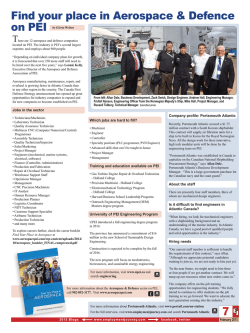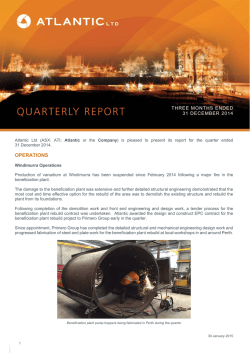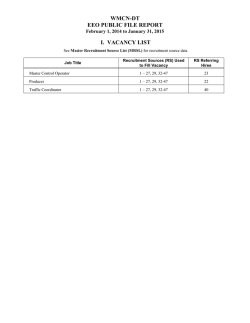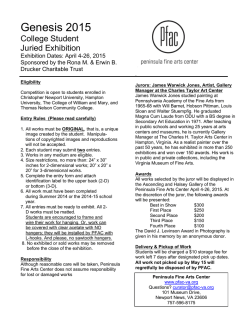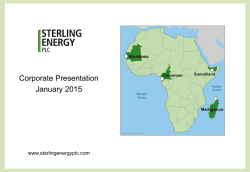
Tectonic model for the latest Triassic
GEOGACETA, 60, 2016 Tectonic model for the latest Triassic-Early Jurassic extensional event in and around the Iberian Peninsula Modelo tectónico para el evento extensional del Triásico final-Jurásico temprano en y alrededor de la Península Ibérica Ramón Vegas1, Juan Tomás Vázquez2, Antonio José Olaiz3 and Teresa Medialdea4 1 Departamento de Geodinámica, Universidad Complutense, c. José Antonio Novais, 4, 28040 Madrid, [email protected] Instituto Español de Oceanografía. C.O. de Málaga, Puerto Pesquero s/n, 29640 Fuengirola, [email protected] 3 Repsol Exploración S.A. 2455 Technology Forest, The Woodlands, Texas 77381, Estados Unidos, [email protected] 4 Instituto Geológico y Minero de España c. Ríos Rosas 23, 28003 Madrid, [email protected] 2 ABSTRACT RESUMEN An array of 200-Ma-old (Lower Jurassic) dolerite dikes in both the eastern and western sides of the Atlantic records an episode of SE directed extension which occurred in and around the Iberian Peninsula. This extensional regime episode is responsible for the formation of the main structures in the Iberian Peninsula and neighboring areas at the beginning of the Jurassic. Una serie de diques básicos de edad Jurásico Inferior (200 Ma), tanto en las zonas orientales como occidentales del dominio Atlántico, permite definir un episodio de extensión con dirección SE que afectó a la Península Ibérica y a las regiones vecinas. Este episodio de régimen extensional es responsable de la formación de las principales estructuras de la Península Ibérica y áreas próximas al comienzo del Jurásico. Key-words: Jurassic, dolerite dikes, extensional event, Iberian Peninsula, Atlantic domain. Palabras clave: Jurásico, diques básicos, episodio extensional, Península Ibérica, dominio Atlántico. Geogaceta, 60 (2016), 23-26 ISSN (versión impresa): 0213-683X ISSN (Internet): 2173-6545 Introduction The rifting and break-up of Pangaea initiated during the Early Triassic and continued and intensified in the Jurassic, coinciding with the onset of a vast magmatic event which extended over the regions now occupying the borders of the Central Atlantic. This volcanic province, one of the largest known Phanerozoic flood basalt province, is currently referred as the Central Atlantic Magmatic Province (CAMP). The northern domain of the CAMP is characterized by the occurrence of large, NE trending, extrabasinal dykes that occur in both the eastern and western sides of the Atlantic–the Iberian Massif, the Anti Atlas Ranges and the coastal plain of New England and the Canadian Maritime Provinces. When plotted in a plate tectonic reconstruction predating the initial break-up of the Atlantic, these dikes indi- Recepción: 15 de febrero de 2016 Revisión: 20 de abril de 2016 Aceptación: 20 de Mayo de 2016 cate the regional direction of extension and hence the overall tectonic framework for the latest Triassic-Early Jurassic stretching and rifting phase. Based in the distribution of these dolerite dikes in a pre-drift reconstruction of the Central and Northern Atlantic Ocean, we present a coherent frame for the generalized crustal extension event, occurred in and around the Iberian Peninsula. The early Jurassic (200 Ma) dolerite dikes CAMP’s lava flows, sills, and dikes emplaced almost simultaneously in an area of more than 7 x 106 km2 (Marzoli et al., 1999; McHone, 2000) forming one of the largest igneous provinces known on Earth. Among the volcanic products, it must be emphasized the occurrence of nine large, NE-trending dikes at both sides of the Copyright© 2016 Sociedad Geológica de España / www.geogaceta.com Central Atlantic and far within the Iberian Peninsula and West Brittany. These dolerite intrusions correspond to the Higganum (Higganum system) dike of New England, NE United States; to the Caraquet, Shelburne and Avalon dikes of the Maritime Provinces, Canada; to the Ighrem and Foum-Zguid dikes of southern Morocco; to the Ksi-Ksou dike of southwest Algeria; to the Plasencia dike of central Spain and southern Portugal; and to the Kerforne dike of Brittany, NW France (Fig. 1). Besides their similar radiometric age, ca. 200 Ma (Marzoli et al., 1999), all these dikes show other common remarkable features: widths 10–50 m, lengths to 400 km even longer, and a prominent NE direction, with the unique exception of the Kerforne dike. Exceptionally, the Foum-Zguid and Plasencia dikes are well exposed and show a series of segments 23 GEOGACETA, 60, 2016 R. Vegas, J.T. Vázquez, A.J. Olaiz and T. Medialdea Fig. 1.- Location of the early Jurassic (200 Ma) dolerite dikes in a Central-North Atlantic pre-drift reconstruction (modified after Greiner and Neugebauer, 2013). Dikes: HS–Higganum System, C–Caraquet, S–Shelburne, I–Ighrem, FZ–Foum-Zguid, KS–Ksi Ksou, A–Avalon, P–Plasencia, K–Kerforne. Arrows indicate the direction of extension. Broken lines are the simplified boundaries of the continental blocks used in the plate reconstruction. Fig. 1.- Situación de los diques doleríticos jurasicos (200 Ma) en una reconstrucción de Pangea modificada de Greiner y Neugebauer (2013). Diques: HS–Higganum System, C–Caraquet, S–Shelburne, I–Ighrem, FZ–Foum-Zguid, KS–Ksi Ksou, A–Avalon, P–Plasencia, K–Kerforne. Las flechas señalan la dirección de extensión. Las líneas discontinuas son los bordes simplificados de los bloques continentales usados en la reconstrucción. with extensional-like relays, and curved conjugate terminations in an en-échelon pattern. The plate reconstruction and the extensional event When plotted in a Pangaea configuration at 200 Ma (the age of their emplacement), the dikes appear to be consistent with a generalized extensional regime probing the initial Africa-North America rupture in the Central Atlantic (Fig. 1). For this pre-drift reconstruction, we have used the Pangaea configuration in the area of the Central Atlantic, North Atlantic and Arctic Oceans, published recently by Greiner and Neugebauer (2013). This tectonic reconstruction is based on an up-todate compilation of Euler rotations describing 24 consistently the evolution of the aforementioned oceans. As usual, dikes are related to a specific stress field in which that the dike orientation is perpendicular to the least-compressive stress. Thus, the large, NE-trending dikes can be ascribed to a general NW-SE extensional tectonic regime (Fig. 1) that preceded the early Jurassic initial rupture of Pangaea, i.e. the drifting phase between Africa and North America (Beutel et al., 2005). This extensional regime is coeval with the initial break-up and the formation of the first oceanic crust between Africa and North America whose age has been determined as 195 Ma by Sahabi et al. (2004). In addition, the continental breakup in the Central Atlantic triggers the intensification of left-lateral motion between Africa and the Iberian Peninsula, as well as the onset of a more complex continental fragmentation between North America and Europe. Since the steady formation of oceanic crust continued during the Jurassic, it is reasonable to assume a long-term continued extensional regime and a tectonic setting for the extensional elements that controlled the formation of the latest-Triassic Early Jurassic basins in the Iberian Peninsula and nearby areas. The Early Jurassic extensional patterns In this NW-SE extensional stress field scenario, several tectonic realms can be considered at the initiation of drifting between Africa and North America (Fig. 2). Localized crustal extension along the oceanic axis of the narrow Central Atlantic originated the Geología Estructural y Tectónica / Structural Geology and Tectonics Tectonic model for the latest Triassic-Early Jurassic extensional event in and around the Iberian Peninsula separation of the conjugate margins of Africa and North America. An almost orthogonal rifting must have been related to the rapid creation of the first oceanic crust. Nevertheless, in North Africa and the Iberian Peninsula the crustal extension seems to be largely distributed and controlled by the left-lateral motion of Africa due to the opening of the Central Atlantic. In this context, it must be stressed that the Early Jurassic opening of the Central Atlantic is not only responsible for the formation of the paired margins of North America and Africa, but also for the simultaneous eastward displacement of Africa. This displacement occurred along a complex intracontinental, left-lateral transform-like zone, which apparently connected the Atlantic spreading axis with the nascent Alpine oceanic realm. Most relative motion between Africa and North America was took along this complex transform zone, named here as the South Iberian System (SIS, Fig. 2). This intracontinental transform fault configured the westernmost, nascent plate boundary between Africa and North America and may be responsible for the tectonic framework that controlled the evolution of several individual basins arranged in an en échelon pattern. These basins should be considered as part of the Early Jurassic rifting event in the Tagus, Algarve, Subbetic and Prebetic Basins, the two latter now included in the Betics. In addition, a lesser part of the displacement of Africa occurred along a left-lateral transcurrent fault, a possible secondary plate boundary, which now constitutes the southern border of the High Atlas. The formation of the Early Jurassic Basins along the Atlasic System (AS, Fig. 2) must be ascribed to oblique rifting as suggested by Mattauer et al. (1977). The Jurassic basin of the Middle Atlas in particular, represents the oblique connection between the two shear zones corresponding to the SIS and the AS (Fig. 2). GEOGACETA, 60, 2016 To the north of the SIS, the main plate boundary, the Iberian Peninsula was eastward trailed in the wake of the displacement of Africa. This caused the incipient orthogonal rifting in the future margins of the Grand Banks, North Portugal and Galicia. Also, contemporaneous with this rifting, the eastward motion of Africa induced the displacement of the Iberian Peninsula by means of a series of transtensional basins along the PyreneanCantabrian System (PCS, Fig. 2). The displacement was dominant in the left-lateral faults bounding the basins as described by Tugend et al. (2015). The PCS presumably recorded some type of failed plate boundary during this extensional event. Coeval with this eastward displacement is considered the oblique extension in the interior of the Iberian Peninsula along the Iberian Rift (Fig. 2). This oblique extensional regime must have been bounded by discontinuous left-lateral faults (Vegas et al., 1996). Fig. 2.- Main features of the early Jurassic extensional episode in a plate tectonic reconstruction derived from the figure 1. AS–Atlasic System, SIS– South Iberian System, PCS–Pyrenean-Cantabrian System, GB–Grand Banks, MA–Middle Atlas, IR–Iberian Rift, C-CF–Cobequid-Chebaducto Fault, GF– Gafsa Fault. Fig. 2.- Estructuras principales del episodio extensional jurásico en una reconstrucción de placas derivada de la figura 1. AS–Sistema del Atlas, SIS–Sistema Sur Ibérico, PCS–Sistema Pirenaico-Cantábrico, GB–Grand Banks, MA–Atlas Medio, IR–Rift de Iberia, C-CF–Falla de Cobequid-Chebaduct, GF–Falla de Gafsa. Geología Estructural y Tectónica / Structural Geology and Tectonics 25 GEOGACETA, 60, 2016 In summary, a generalized extensional episode in the Iberian Peninsula and neighbouring regions began in the latest Triassic and continued during the early Jurassic. This extensional regime is responsible for the formation of the main structures in and around the Iberian Peninsula. R. Vegas, J.T. Vázquez, A.J. Olaiz and T. Medialdea This extensional tectonic scenario generated the main structures that constrain the basin formation in the Iberian Peninsula and NW Africa. Acknowledgements The authors acknowledge the constructive revisions of A. Casas and J.L. Granja. Concluding remarks References The location of an array of 200Ma old dolerite dikes in a Pangaea reconstruction records a generalized, SE-directed, extensional event for the Iberian Peninsula and neighbouring regions. Beutel, E.K., Nomade, S., Fronabarger, A.K. and Renne, P.R. (2005). Earth and Planetary Science Letters 236, 471–485. Greiner, B. and Neugebauer, J. (2013). International Journal of Earth Sciences 102, 26 1357–1376. Marzoli, A., Renne, P.R., Piccirillo, E.M., Ernesto, M., Bellieni, G. and De Min, A. (1999). Science 284, 616–618. McHone, J.G. (2000). Tectonophysics 316, 287–296. Mattauer, M., Tapponier, P. and Proust, F. (1977). Bulletin de la Société Géologique de France 7, 521–526. Sahabi, M., Aslanian, D. and Olivet, J.L. (2004). Comtes Rendus Géosciences 336, 1041–1052. Tugend, J., Manatschal G. and Kusznir, N.J. (2015). Geology 43, 15–18. Vegas, R., Juarez, M.T. and Kälin, O. (1996). Geogaceta 19, 11–12. Geología Estructural y Tectónica / Structural Geology and Tectonics
© Copyright 2026


